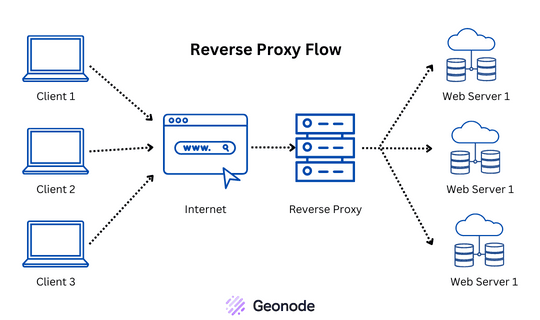What is a Proxy Server?
Before diving in-depth into reverse proxies, let's first define a proxy server. A proxy server is an intermediary between a client and a server. When a client makes a request to a server, the request is first sent to the proxy server. The proxy server then forwards the request to the server on behalf of the client. The server responds to the proxy server, which then forwards the response back to the client.

How Does a Reverse Proxy Work?
When a client sends a request to a server through a reverse proxy, the request is first intercepted by the proxy. The reverse proxy then evaluates the request and forwards it to the appropriate server based on a set of predefined rules. The server processes the request and sends the response back to the reverse proxy. The reverse proxy then evaluates the response and forwards it back to the client.
Benefits of Using a Reverse Proxy
There are several benefits to using a reverse proxy, including improved performance, increased security, scalability, and load balancing.
Improved Performance: Caching reverse proxies stores frequently accessed content, reducing the number of requests that need to be sent to the web server. This reduces the load on the server and speeds up response times. Load balancers distribute traffic among multiple servers, ensuring that no one server is overloaded and reducing the risk of downtime.
Increased Security: Reverse proxies can act as a buffer between the client and the web server, protecting the server from malicious requests. SSL/TLS termination proxies handle encryption and decryption, adding an extra layer of security to web applications. Reverse proxies can also be used to filter incoming requests, blocking malicious traffic and protecting against DDoS attacks.
Scalability: Reverse proxies can be used to horizontally scale web applications by distributing traffic among multiple servers. This makes it possible to handle large amounts of traffic without overloading any one server.
Load Balancing: Load balancers distribute traffic among multiple servers to improve performance and prevent downtime. They can be used to ensure that no one server is overloaded and can also be used to perform health checks on servers, automatically removing any servers that are not responding.
Forward Proxy VS Reverse Proxy
How do forward proxies differ from reverse proxies? While reverse proxies sit between client devices and web servers, forward proxies sit between client devices and the internet.
When a client makes a request to a website, the request is sent to the forward proxy, which then forwards the request to the web server on behalf of the client. Forward proxies are often used to bypass content filters or to provide anonymity.
Use cases for forward and reverse proxies differ. Individuals often use forward proxies to bypass internet restrictions or access geo-restricted content. On the other hand, reverse proxies are typically used by web applications to improve performance, increase security, and provide scalability.
Implementing a Reverse Proxy
Setting up a reverse proxy can help improve web servers' performance, security, and scalability. Implementing it is a relatively straightforward process. Below are some steps you can follow.
Setting up a reverse proxy
Choose a reverse proxy server: There are several reverse proxy servers available, including Nginx, Apache, and HAProxy. Choose the server that best meets your needs and install it on your server.
Configure the reverse proxy server: Configure the reverse proxy server to intercept requests and forward them to the appropriate backend server. This involves setting up rules and algorithms to determine which backend server to forward requests to based on factors like load balancing, server health, and request type.
Test the reverse proxy: After configuring the reverse proxy, test it to ensure that it is working correctly. Send requests to the reverse proxy and verify that they are being forwarded to the backend server as intended.
Common pitfalls and how to avoid them
Configuration errors: One of the most common pitfalls when setting up a reverse proxy is misconfiguration. This can result in requests not being forwarded correctly or the reverse proxy server becoming overloaded.
To avoid this, carefully review the configuration settings for your reverse proxy server, and test it thoroughly before deploying it in a production environment.
Inadequate security: Reverse proxies can help improve the security of web servers, but only if they are configured correctly. Failing to properly secure your reverse proxy server can leave it vulnerable to injection attacks or DDoS.
To avoid this, ensure that your reverse proxy server is configured with the latest security updates and follow the best practices for securing web servers.
Best practices for configuring a reverse proxy
Use SSL/TLS encryption: SSL/TLS encryption can help secure the communication between the client and the reverse proxy server, as well as between the reverse proxy server and the backend server.
Use caching: Caching can help improve the performance of your web server by reducing the number of requests that need to be forwarded to the backend server.
Monitor your reverse proxy: Regularly monitor your reverse proxy server to ensure it performs as expected and identify any potential issues before they become critical.
Examples of Reverse Proxies in Use (Use Cases)
Reverse proxies are widely used in a variety of applications to improve performance, scalability, and security.
Popular reverse proxy software
There are several popular reverse proxy software options available, including:
Nginx: Nginx is a high-performance, open-source reverse proxy server that is widely used for load balancing and caching.
Apache: Apache is another open-source reverse proxy server that is commonly used for load balancing and caching.
HAProxy: HAProxy is a high-performance reverse proxy and load balancer that is popular for its scalability and reliability.
Real-world applications of reverse proxies
Reverse proxies are used in a variety of real-world applications, including:
Content delivery networks (CDNs): CDNs use reverse proxies to cache and serve content to users from servers located closer to them, improving performance and reducing latency.
E-commerce websites: Reverse proxies can be used to handle high volumes of traffic during peak shopping periods, improving website performance and reliability.
API gateways: Reverse proxies can be used to manage and secure API requests, routing them to the appropriate backend server based on request type or user authentication.
Case studies of successful reverse proxy implementation
Reddit: Reddit uses Nginx as its reverse proxy server, allowing it to handle millions of requests per day and improve website performance and reliability.
Airbnb: Airbnb uses HAProxy as its reverse proxy server, allowing it to handle high volumes of traffic during peak booking periods and improve website performance and reliability.
Netflix: Netflix uses a custom-built reverse proxy and load balancer called Zuul, which allows it to manage and route API requests for its streaming service.
Conclusion
The future looks bright for reverse proxies as more businesses and websites look to improve their online performance and security. With the rise of cloud computing and distributed systems, reverse proxies will continue to play an important role in managing network traffic and optimizing server resources.
Additionally, machine learning and artificial intelligence advancements may lead to even more sophisticated reverse proxy technologies that can adapt to changing network conditions in real-time.
If you're looking to improve your website's performance and security, consider implementing a reverse proxy. With several popular software options available and a variety of real-world applications, there's a reverse proxy solution that can meet your specific needs.
When setting up a reverse proxy, be sure to follow best practices and avoid common pitfalls to ensure optimal performance and security. You can take your online presence to the next level by leveraging the power of reverse proxies. For your proxy needs, check out Geonode.
Frequently Asked Questions (FAQs)
-
What is a reverse proxy?
A reverse proxy is a server that acts as an intermediary between clients and servers, intercepting and processing requests before passing them on to the appropriate server or group of servers.
-
How does a reverse proxy work?
A reverse proxy works by intercepting client requests and processing them before forwarding them to the appropriate server or group of servers. This allows for load balancing, caching, and improved security.
-
What are the benefits of using a reverse proxy?
The benefits of using a reverse proxy include improved website performance, increased security, scalability, and load balancing. Additionally, reverse proxies provide a single point of entry for traffic filtering and routing, which can improve network efficiency.
-
How is a reverse proxy different from a forward proxy?
A reverse proxy intercepts requests on behalf of servers, while a forward proxy intercepts requests on behalf of clients. Forward proxies are commonly used for anonymity or content filtering, while reverse proxies are used for load balancing and website optimization.
-
How is a reverse proxy implemented?
Reverse proxies can be implemented through various software or hardware solutions, including NGINX, Apache, and HAProxy. The implementation process may involve configuring the proxy server and routing traffic to the appropriate backend servers. Following best practices to avoid common pitfalls is important in ensuring optimal performance and security.


